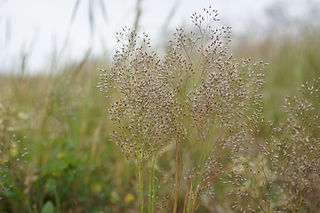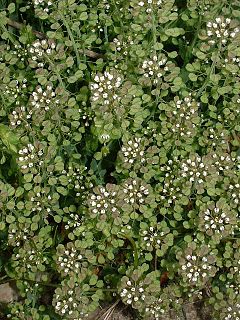
Lycium is a genus of flowering plants in the nightshade family, Solanaceae. The genus has a disjunct distribution around the globe, with species occurring on most continents in temperate and subtropical regions. South America has the most species, followed by North America and southern Africa. There are several scattered across Europe and Asia, and one is native to Australia. Common English names for plants of this genus include box-thorn and desert-thorn.
Microlechia chretieni is a moth in the family Gelechiidae. It was described by Turati in 1924. It is found on the Canary Islands, Madeira, Crete and Sardinia, as well as in North Africa, France, Portugal, Spain, Greece and Palestine. It is also present in Saudi Arabia, southern Iran, western Pakistan, Mozambique, Namibia and South Africa.

Aira cupaniana is a species of annual herb in the family True grasses. They have a self-supporting growth form and simple, broad leaves. Individuals can grow to 13 cm.

Ajuga iva is a species of perennial herb in the family Lamiaceae. They have a self-supporting growth form and simple, broad leaves. Individuals can grow to 5 cm. Subspecies include Ajuga iva subsp. iva and Ajuga iva subsp. pseudoiva.

Astragalus hamosus, the southern milk vetch or European milk vetch, is a plant in the family Fabaceae.
Callitriche truncata is a species of tree in the family Plantaginaceae. They have a self-supporting growth form and simple, broad leaves. Individuals can grow to 10 cm tall.
Crupina crupinastrum, also known as false saw wort, is a species of annual herb in the family Asteraceae. They have a self-supporting growth form and simple, broad leaves. Flowers are visited by scarce swallowtail, Hoplitis, Trichodes, and brimstone. Individuals can grow to 40 cm.
Diplotaxis viminea is a species of annual herb in the family Brassicaceae. They have a self-supporting growth form and simple, broad leaves. Individuals can grow to 5.8 cm tall.
Eleocharis ovata is a species of annual grass in the family Cyperaceae (sedges). They have a self-supporting growth form and have simple, broad leaves and green flowers. Individuals can grow to 1.5 feet.

Fumaria flabellata is a species of plants in the family Papaveraceae.
Hypericum australe is a species of plant in the family Hypericaceae. Individuals can grow to 24 cm tall.

Lotus ornithopodioides, the southern bird's foot trefoil, is a species of annual herb in the family Fabaceae. They have a self-supporting growth form and compound, broad leaves. Individuals can grow to 5 cm tall.
Lycium ferocissimum, the African boxthorn, is a species of shrub in the family Solanaceae (nightshades). They have a self-supporting growth form. Individuals can grow to 1.5 m.

Melilotus messanensis is a species of annual herb in the family Fabaceae. They have a self-supporting growth form and compound, broad leaves.
Micromeria microphylla is a species of plants in the family Lamiaceae.
Valerianella eriocarpa is a plant species in the family Caprifoliaceae.

Pimpinella peregrina is a species of biennial herb in the family Apiaceae. They have a self-supporting growth form and simple, broad leaves. Individuals can grow to 0.72 m.
Romulea variicolor is a species of plant in the family Iridaceae.
Spergularia diandra, the alkali sandspurry, is a species of annual herb in the family Caryophyllaceae (carpetweeds). They have a self-supporting growth form and simple, broad leaves. Individuals can grow to 4.4 cm.

Thlaspi perfoliatum is a species of plants in the family Brassicaceae.









